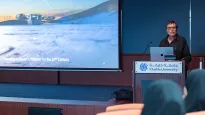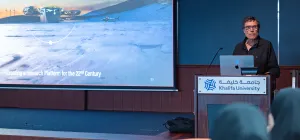Guus Luppens on Increasing PEA’s Energy Production Capacity

Guus Luppens, an electromechanical engineer who first travelled to Antarctica during the 2018-2019 research season, was tasked with handling a number of maintenance tasks for Princess Elisabeth Antarctica’s renewable energy production systems. We spoke with him about the work he had done with his colleague Johan Demuylder during the most recent season (2020-2021) at the station.
What were your primary objectives at the Princess Elsiabeth Antarctica this year? Were you able to accomplish them?
This season's goal was to increase renewable energy production to meet the increasing demand due to the expansion of the station to higher occupancy. The station was initially designated to host 18 people when it first opened in 2009; this past season we’ve made it possible to host 45 people.
We also replaced old-generation solar panels on the fuel platform's roof with new solar panels with two faces. The top face catches incidental solar radiation from the sun and the bottom face catches radiation reflected from the snow below it. Now each module produces almost 500 Watts per module, which is a lot compared to a single-faced solar panel, which produces only 345 Watts per module.
Thanks to the new double-sided solar panel modules, renewable energy production at the station almost doubled. With more people staying at the station, areas of the station such as the kitchen use more energy than before, so it’s good that we increased renewable energy production.
Once we installed the new double-faced solar panel modules, we worked for a week in-stalling 32 new solar panel modules on the new garage’s façade. We mounted them vertically on the façade because they get a lot of direct sunlight when the sun is low in the west in the late afternoon, which allows them to produce a lot of energy at this time of day. These new panels help to prevent any possible gaps in afternoon energy production.
How much have you been able to increase the energy production capacity of the station? What is the station's potential peak production capacity?
We mangled to increase the peak power of the solar panels by 43%, which is an outstanding result! In terms of how many extra kWh we produce, it's difficult to say, as we installed new solar panel technology this season, and the solar arrays are at different angles and orientations.
For us, maintaining continuous energy production throughout the day is more important than what is produced during peak production, as the goal is the sustainable use of energy. This means we don’t rely as heavily on the batteries as before.
Have you observed changes in the energy production capacity since you first started working at the station three seasons ago?
Yes, I’ve observed changes. What we’ve implemented has had some fascinating outcomes.
Last year, we installed several new and improved dump load systems. These are intelligent controllers that can convert excess renewable energy into heat. In the past, this potential excess energy was simply not harvested and was forever lost. Now, when the station's battery arrays are full, excess renewable energy production gets put to good use, for example, towards a hot water tank that creates hot water for the station, or toward ambient heaters for the station’s annexes.
As a side effect, the wind turbines are slowed every time energy is consumed in the station (they are designed to do this), meaning there is less need for wind turbine maintenance.
Would any of this have been possible to accomplish without Johan?
Definitely not! Johan and I make a great team! He did almost all of the installation work, and I assisted him. A lot of planning and design goes into these kinds of procedures at the beginning of each season.
Once the solar panels are installed, we need to connect them and configure e-inverters to get the solar panels connected to the main building. For this, I was grateful to have Johan on board, as we could share the installation work.
How do you think PEA could be a model for people to increase renewable energy use and reduce their energy consumption?
Princess Elisabeth Antarctica is the best example to show that we do not have to rely on fossil fuels for our energy needs. Even in a remote and harsh place like Antarctica, we succeed at being 100% energy-sufficient using renewable energy. If we can accomplish this in Antarctica, it is undoubtedly possible to reproduce this in Europe or elsewhere in the world.
We must also remember that Princess Elisabeth Antarctica was built more than ten years ago when renewable energy technology was not as developed as it is today. Today renewable energy is cheaper and a lot easier to install.
What have you been doing since your return to Belgium?
I have a lot of work waiting for me! We’re planning many meetings with IPF to evaluate the past season and start working on new renewable energy designs for next season!
Do you plan to go back to the station for the next season?
Two days before I left for Antarctica, I found out that my girlfriend was pregnant!
At first, I thought that becoming a father would keep me from going back to PEA. However, when you’re expecting a child, you reflect a lot on what the future will be like for future generations. I concluded that the best way to give my child a fair, sustainable and environmentally safe future would be to make sure I continue supporting climate change research as much as possible. So yes, I do hope to be able to go back to PEA.
Download





















